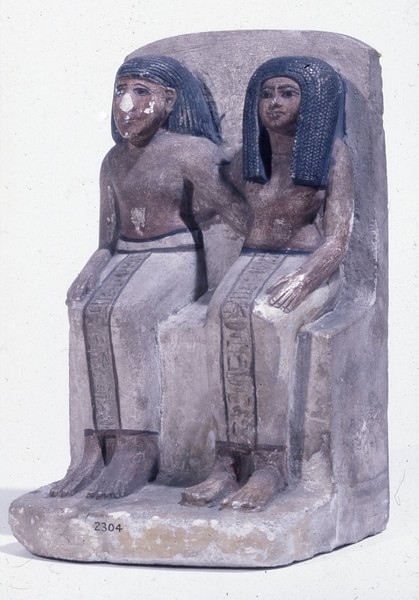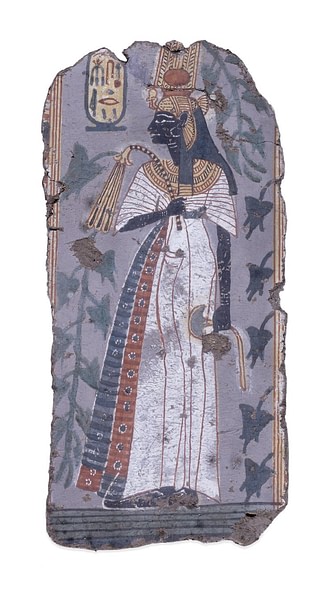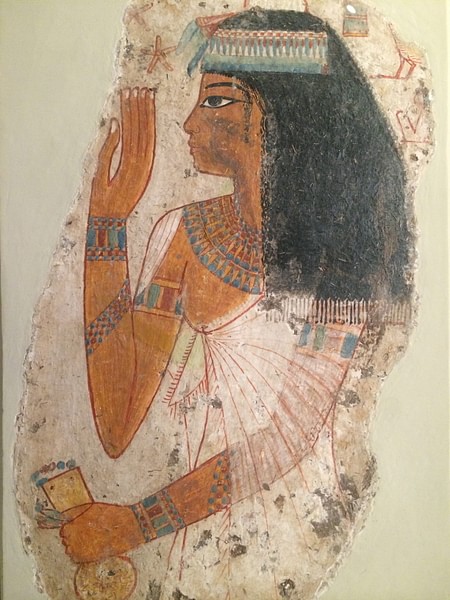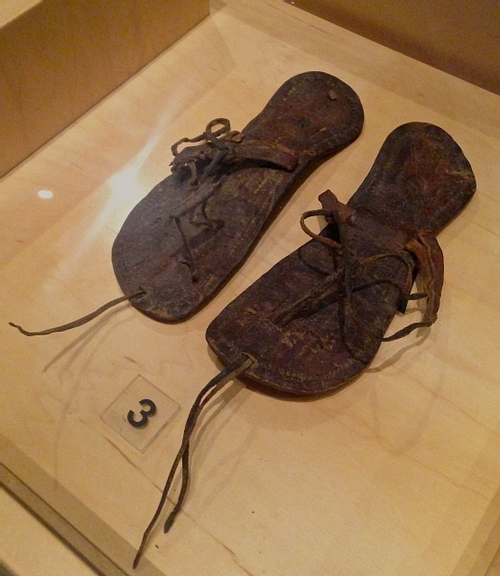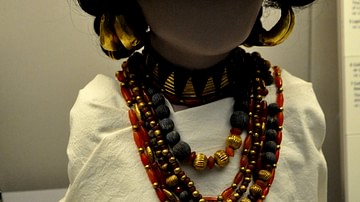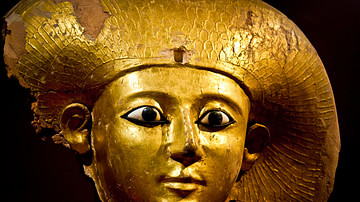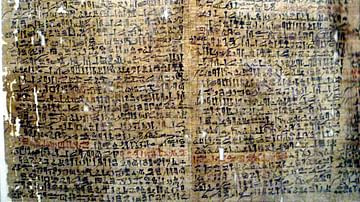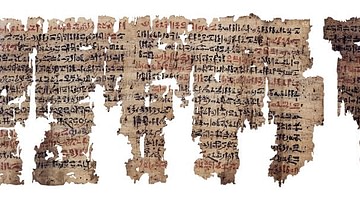Fashion in ancient Egypt epitomized the concept of simplicity and ease in movement and remained relatively unchanged in this regard for over 3,000 years. Clothing and footwear differed in ornamentation between the upper and lower classes but, overall, men and women's clothing took the same basic forms in any era, quite unlike fashion in the modern era.
In 1851, a woman named Amelia Bloomer in the United States shocked the establishment by announcing in her publication The Lily that she had adopted the "Turkish Dress" for daily wear and, further, provided readers with instructions to make their own. This "Turkish dress" was a pair of light-weight pants worn under a dress which dispensed with the heavy petticoats and undergarments which constituted women's fashion.
At the time of Bloomer's announcement, upper-class women were wearing dresses comprised of as many as 16 petticoats, which were quite heavy, and those of the lower classes were almost equally constrained. These "Turkish pants" (which came to be known as "bloomers") emancipated women from the constraints of fashion, allowing them freedom of movement, and became one of the symbols of the new women's suffrage movement.
The Women's Suffrage Movement had only just met to issue their Declaration of Rights and Sentiments, written by Elizabeth Cady Stanton, in 1848 at Seneca Falls, NY, and Bloomer's advocacy of the new style was embraced by one of the pivotal figures of the movement, Lucy Stone, who wore the pants during her lectures on women's rights. It was Lucy Stone who would encourage Susan B. Anthony to take up the cause of the women's suffrage movement and Anthony, of course, is now synonymous with women's rights.
All of these challenges to the patriarchy of the 19th century were quite disturbing, to women as well as men, but they would have been of no consequence to the ancient Egyptians who viewed women as near-equals and whose fashion sense was could be described as "unisex" long before that word, or concept, was understood by the more "advanced" culture of the present day.
Egyptian fashion was practical, simple, and, for most of the population, the same kind of outfit worn by a woman was worn by a man. The upper-class women in the Old Kingdom of Egypt (c. 2613-2181 BCE) wore longer dresses which covered their breasts, but the women of the lower classes would have worn the same simple kilt as their fathers, husbands, and sons.
Early Dynastic Period & Old Kingdom
Images from the Early Dynastic Period in Egypt (c. 3150 - c. 2613 BCE) show men and women of the lower class in the same kind of dress: a knee-length, plain kilt, probably white or light in color. This would have been made of cotton, linen, or byssus (flax) and was fastened around the waist by a belt of cloth, papyrus rope, or leather.
Upper-class Egyptians in the same time period dressed the same only with more ornamentation. Egyptologist Helen Strudwick observes how "only by their jewelry could men from the wealthy class be distinguished from farmers and artisans" (374). Women's dress was more distinctive between classes as upper-class women wore a long, figure-fitting dress with or without sleeves. These dresses were held in place by straps over the shoulders and sometimes were supplemented by a sheer tunic worn over them.

Women's fashions which bared the breasts were not a matter of concern. The upper-class women's dresses sometimes began below the breasts and went to the ankles. Lower-class women's skirts, as noted, were from the waist to the knees without a top. Before the development of linen, people wore clothes made of animal hide or woven papyrus reeds. Strudwick writes:
Shepherds, ferrymen, and fishermen mainly made do with a simple leather sash from which hung a curtain of reeds; many also worked completely naked, at least until the Middle Kingdom - during this time it became rare to see an unclothed worker. Female millers, bakers, and harvest workers are often depicted in a long wraparound skirt but with the upper part of the body bared. (376)
Children of both sexes wore no clothes from birth until puberty and some occupations, as Strudwick notes, continued this practice. The washermen and washerwomen who worked daily by the banks of the Nile River washing other people's clothing performed their tasks naked because they were in the water so frequently.
First Intermediate Period & Middle Kingdom
The First Intermediate Period of Egypt (c. 2181-2040 BCE) followed the collapse of the Old Kingdom and initiated many dramatic changes in the Egyptian culture but fashion remained relatively the same. It is only in the Middle Kingdom of Egypt (2040-1782 BCE) that fashion changes as women begin to wear long cotton gowns and different hairstyles.
In the Old Kingdom and First Intermediate Period women are depicted with hair length just below their ears while, in the Middle Kingdom, their hair is worn to their shoulders. The Middle Kingdom dress of the upper class is also different in that outfits were often made of cotton. These dresses, still form-fitting, were often sleeved with a plunging neckline ornamented with a clasp necklace at the throat. These dresses would be made of a single sheet of cloth which the woman would wrap herself in and then arrange for style with a belt around the waist over which she could blouse the top.
From the same period, however, there is also evidence of upper-class women's dresses which rose from the ankle to the waist and were held up by thin straps which ran over the breasts and were fastened over the shoulders at the back. Men at this time continued to wear the simple kilt only with pleats at the front. Precisely how the ancient Egyptian pleated their clothing is not known, but images in art clearly show pleats in both men and women's clothing. The most popular article of clothing among upper-class men was the triangular apron; a starched, ornamented kilt which fell to just above the knees and was held by a sash. This would have been worn over a loincloth which was a triangular strip of cloth running between the legs and tied at the hips.
The New Kingdom
Following the Middle Kingdom, Egypt entered the Second Intermediate Period (c. 1782-1570 BCE) during which the foreign people known as the Hyksos ruled from Lower Egypt and the Nubians held the southern frontiers of Upper Egypt with only Thebes in the middle representing Egyptian rule.
The Hyksos gave Egypt many advances, innovations, and inventions which they later made significant use of but do not seem to have contributed to fashion. This is largely because the Hyksos greatly admired Egyptian culture and emulated Egyptian beliefs, behavior, and dress in their cities in the northern Delta.
In c. 1570 BCE, the Theban prince Ahmose I (c. 1570-1544 BCE) drove the Hyksos out of Egypt and initiated the period of the New Kingdom of Egypt (c. 1570-1069 BCE) which saw the greatest advances in fashion in Egyptian history. The fashion styles of the New Kingdom are those most often depicted in films and television shows dealing with Egypt no matter what time period they are set in.
The New Kingdom was the era of Egypt's empire when the country stepped onto the international stage and came into closer contact with other nations than they had previously. Even before the age of empire, however, fashion statements became more elaborate. Ahmose I's wife, Ahmose-Nefertari (c. 1562-1495 BCE), is depicted in a dress with winged sleeves and a wide collar which falls to above her ankles.
Beaded gowns and dresses (the kalasiris which Herodotus mentions) ornamented with jewels begin to appear in the late Middle Kingdom but become more common in the New Kingdom among the upper classes. Elaborate wigs adorned with beads and jewels also appear with greater frequency at this time. Egyptologist Margaret Bunson notes how "the capelet, made of sheer linen, was the fashion innovation of the New Kingdom" (68). The capelet, or shawl cape, was a rectangle of linen twisted, folded, or cut, and usually attached to an ornamented collar. It was worn over a kalasiris which fell either from the waist or just below the breasts and became the most popular style of the upper classes.
Men's fashion also advanced fairly quickly in the New Kingdom. The kilts of this period drop to below the knee, are more intricately embroidered, and they are often supplemented by a sheer, loose-fitting, blouse. The pharaoh, depicted in the nemes headdress, is often seen in this kind of clothing wearing either sandals or slippers. Bunson notes how men "wore kilts and sheer blouses with elaborately pleated sleeves. Great panels of woven materials hung from the waist and intricate folds were visible under sheer overskirts" (68). This style was popular with the royalty and upper classes who could afford the material.
The lower classes continued to wear the simple kilt, for both sexes, but now more women of the working class appear with covered tops. Previously, Egyptian servants are depicted in tomb paintings and other art as naked or nearly so but, in the New Kingdom, a number of servants are shown not only fully clothed but in fairly elaborate dresses. Strudwick writes:
The clothes worn by the servants of officials and dignitaries were more refined than those of simple folk. A servant depicted in an Eighteenth Dynasty tomb wears a finely pleated linen tunic and loincloth with a wide, pleated sash. (376)
Underwear was also developed further during this period, evolving from the rough, triangular loincloth wrapped between the legs and around the waist to a finer piece of cloth either sewn to a certain waist size or tied at the hips. Upper-class men's fashion in the New Kingdom was this underwear beneath a loincloth over which was worn a long sheer shirt falling to the knees, a broad neck piece (for nobility), bracelets, and sandals. King Tutankhamun (c. 1336-c.1327 BCE) was buried with over 100 of this kind of underwear as well as shirts, jackets, kilts, and cloaks, providing some of the best examples of New Kingdom fashion yet found.
Women's fashion from the period was more elaborate than in any previous era. Men and women of Egypt often shaved their heads to prevent lice and to cut down on the time it would take to maintain a full head of hair. Wigs were used by both sexes to protect the scalp and for ceremonial purposes. The wigs of the New Kingdom are the most ornate, especially for women, and show pleated, fringed, and layered hair styles with a length to the shoulders or below. Sheer gowns of light linen were in favor among the upper-class women, often ornamented with a sash or cape, belted at the waist, and accented by a headpiece, necklace, and earrings.
Different professions also adopted fairly consistent styles of fashion. Viziers, for example, wore a long skirt (often embroidered) which fastened under the arms and fell to the ankles along with sandals or slippers. Scribes wore the simple waist-to-knee kilt and are sometimes seen in a sheer blouse. Priests wore white linen robes and, according to Herodotus, could wear no other color as white symbolized purity and the sacred. Soldiers, guards, and police forces also wore the simple kilt with sandals and sometimes wrist guards. Farmers, brewers, tavern keepers, masons, laborers, and merchants are uniformly depicted from this period in the same simple kilt, both male and female, though the merchant sometimes appears in a robe or a cloak. Coats, jackets, and cloaks were common throughout Egypt's history as the temperature at night, and especially in the rainy season, could be quite cold.
Footwear & Accessories
Perfume and jewelry were appreciated and worn by both men and women, as were cosmetics. Egyptians of both sexes used kohl under their eyes to decrease sun glare and kyphi, the most popular Egyptian perfume, was regarded so highly it was burned as incense in the temples. Images of Egyptians with cones on their heads are depicting the use of kyphi in its cone form. It was composed of frankincense, myrrh, pine resin, and other ingredients and could be burned (as with the cones), applied to the skin, or used as toothpaste and mouthwash.
Kyphi was most often used by women and applied in very much the same fashion as perfume is in the modern day. A woman, or her maidservant, would open a container of kyphi, fan the air, and walk through the scent. The same is true of cosmetics, which were kept in pots or jars and applied from these containers with a brush or reed, much like the modern eyeliner.
The most popular form of jewelry among the upper classes was gold-based. The Egyptian word for gold was nub, and once the land to the south had been conquered, it came to be called Nubia for the vast amounts of gold found there. All classes of Egyptians wore some kind of jewelry as Strudwick notes:
Virtually every form of jewelry has been recorded, including finger rings, anklets, armlets, girdles and pectorals, necklasces, torques, chokers, diadems, ear studs, earrings, and hair ornaments. Colored semi-precious stones, such as cornelian, turquoise, feldspar, green and red jasper, amethyst, quarts, agate, and lapis lazuli were the most commonly used stones. Often, however, they were imitated by coloured glass and faience. (386)
Footwear was practically non-existent among the lower classes, but in cold weather or rough terrain, they seem to have wrapped their feet in rags. Among the upper classes sandals and slippers were worn but, like the lower classes, people usually went barefoot. Sandals were made of wood, papyrus, leather, or a combination of these and were fairly expensive. Tutankhamun's tomb contained 93 pairs of sandals in different styles and one even of gold. Slippers were made of papyrus rushes woven together but could be supplemented with cloth interiors.
There is some evidence of shoes being worn by nobility in the New Kingdom and also the use of silk but this is rare. The Hittites had developed the shoe and the boot by this time, so it would not be surprising to see their appearance in Egypt. In 1258 BCE the Hittites and Egyptians signed the world's first peace treaty, and afterwards cultural diffusion was common between the two. Still, the shoe never became popular footwear in Egypt as it would probably have been considered unnecessary effort; after all, even the gods went barefoot.
Manufacture & Simplicity of Form
The earliest clothing was probably papyrus reeds and animal skins, but this changed with the cultivation of flax which was processed and turned into cloth. Women were the first cultivators of flax and initiated the manufacture of clothing. Evidence for this claim is the oldest depictions of textile production showing women at work, not men, and women continuing in textile production even when the industry was run by males. This is not at all unusual as women were the first brewers in Egypt and, most likely, the first healers who predated the rise of the medical profession.
Making clothing began in the home but soon turned into an industry once linen, and later cotton, became popular. Flax fibers were spun into thread and woven on a horizontal loom to create one long piece of cloth, which then was cut. Even the most elaborate dresses and kilts were simply a bolt from this cloth which was rarely sewn into any shape. The kalasiris was little more than a sheet a woman wrapped around her body; the individual turned that sheet into a dress through personal skill in manipulating the cloth.
Simplicity was the central value of Egyptian fashion even when styles became more elaborate in the New Kingdom. The basic concept of Egyptian fashion also did not change much from the time of the Old Kingdom through the Ptolemaic Dynasty (323-30 BCE) which was the last dynasty to rule Egypt before it was annexed by Rome. The kinds of fashion one sees in this later period are very close to those from the New Kingdom which follow the basic form of Old Kingdom dress. It may safely be said that more radical changes have taken place in fashion in the last 150 years than in the whole span of Egyptian history, but this is only because the ancient Egyptians understood that simplicity of style can often be the most elegant and certainly the most classic.
